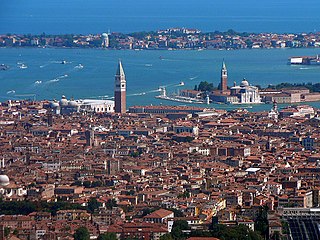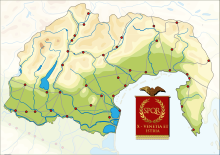
Aquileia is an ancient Roman city in Italy, at the head of the Adriatic at the edge of the lagoons, about 10 kilometres (6 mi) from the sea, on the river Natiso, the course of which has changed somewhat since Roman times. Today, the city is small, but it was large and prominent in classical antiquity as one of the world's largest cities with a population of 100,000 in the second century AD and is one of the main archaeological sites of northern Italy. In late antiquity the city was the first city in the Italian Peninsula to be sacked by Attila the Hun.

The Veneti were an Indo-European people who inhabited northeastern Italy, in an area corresponding to the modern-day region of Veneto, from the middle of the 2nd millennium BC and developing their own original civilization along the 1st millennium BC.

Cisalpine Gaul was the name given, especially during the 4th and 3rd centuries BC, to a region of land inhabited by Celts (Gauls), corresponding to what is now most of northern Italy.

Northeast Italy is one of the five official statistical regions of Italy used by the National Institute of Statistics (ISTAT), a first level NUTS region and a European Parliament constituency. Northeast encompasses four of the country's 20 regions:

Italia, also referred to as Roman Italy, was the homeland of the ancient Romans. According to Roman mythology, Italy was the ancestral home promised by Jupiter to Aeneas of Troy and his descendants, Romulus and Remus, who were the founders of Rome. Aside from the legendary accounts, Rome was an Italic city-state that changed its form of government from Kingdom to Republic and then grew within the context of a peninsula dominated by the Gauls, Ligures, Veneti, Camunni and Histri in the North, the Etruscans, Latins, Falisci, Picentes and Umbri tribes in the Centre, and the Iapygian tribes, the Oscan tribes, and Greek colonies in the South.

Altinum was an ancient town of the Veneti 15 km southeast of modern Treviso, close to the mainland shore of the Lagoon of Venice. It was also close to the mouths of the rivers Dese, Zero and Sile. A flourishing port and trading centre during the Roman period, it was destroyed by Attila the Hun in 452. The town recovered, but was later abandoned when sea-borne sand began to cover it over. Its inhabitants moved to Torcello and other islands of the northern part of the lagoon.

The Via Popilia is the name of two different ancient Roman roads begun in the consulship of Publius Popilius Laenas. One was in southern Italy and the other was in north-eastern Italy.

Cadore is a historical region in the Italian region of Veneto, in the northernmost part of the province of Belluno bordering on Austria, the Trentino-Alto Adige/Südtirol and Friuli-Venezia Giulia. It is watered by the Piave River which has its source in the Carnic Alps. Once an undeveloped and poor district, the former contado (countship) of Cadore now has a thriving economy based on tourism and a small manufacturing industry, specialising in the production of glasses.

The Triveneto or Tre Venezie, also often referred to as North-Eastern Italy or simply North-East, is a historical region of Italy. The area is made up of the three smaller historical regions of Venezia Euganea, Venezia Giulia and Venezia Tridentina. This territory was named after the Roman region of Venetia et Histria.

Oderzo is a comune, with a population of 20,003, in the province of Treviso, in the Italian region of Veneto. It lies in the heart of the Venetian plain, about 66 kilometres to the northeast of Venice. Oderzo is crossed by the Monticano river, a tributary of the Livenza.

The Vipava Valley is a valley in the Slovenian Littoral, roughly between the village of Podnanos to the east and the border with Italy to the west. The main towns are Ajdovščina and Vipava.
The Via Annia was the Roman road in Venetia in north-eastern Italy. It run on the low plains of the lower River Po and of the lower Veneto and Friuli-Venezia Giulia regions, an area which had many rivers and large marsh areas and bordered the coastal lagoons. It linked Atria to Aquileia, passing through Patavium. Then it got to the mainland coast of the Lagoon of Venice near today's Mestre and passed through Altinum. After this, it went through Iulia Concordia, which was further inland. It was paved only through the main towns. The rest was gravelled. It was six to eighteen metre wide. It played an important part in the Romanization of the region.

The Raeti were a confederation of Alpine tribes, whose language and culture was related to those of the Etruscans. Before the Roman conquest, they inhabited present-day Tyrol in Austria, eastern Switzerland and the Alpine regions of northeastern Italy. After the Roman conquest, the province of Raetia was formed, which included parts of present-day Germany south of the Danube.

The Raša in Croatian Istria is a major river of Croatia's Istria County. It is 23 kilometres (14 mi) long, and its basin covers an area of 279 km2 (108 sq mi). Its mouth is in the long ria of Raša Bay, which is a drowned river valley scoured out when world sea levels fell, then drowned by the rising waters of the post-glacial era. The Raša rises in springs near Pićan and flows south through a steep-sided valley before opening into the head of the Adriatic Sea. The river, although short in length, has an ancient history as a border.
The gens Accia was a plebeian family at ancient Rome during the late Republic. The gens is known primarily from two individuals, Lucius Accius, a tragic poet of the second century BC, and Titus Accius, best known for his prosecution of Aulus Cluentius Habitus in Cicero's oration Pro Cluentio. Other Accii are known from inscriptions.
The gens Acutia was a minor plebeian family at Ancient Rome. Members of this gens are mentioned from the early Republic to imperial times. The first of the Acutii to achieve prominence was Marcus Acutius, tribune of the plebs in 401 BC.

The Metropolitan City of Venice is a metropolitan city in the Veneto region of Italy, one of ten metropolitan cities in Italy. Its capital is the city of Venice. It replaced the province of Venice in 2015 and includes the city of Venice and 43 comuni. It was first created by the reform of local authorities and then established by Law 56/2014.
Sisenna Statilius Taurus was a Roman senator. He was consul for the year AD 16 with Lucius Scribonius Libo as his colleague. Most of our information about Sisenna comes from inscriptions.
The gens Tedia or Teidia was a minor plebeian family at ancient Rome. Only a few members of this gens are mentioned in history, but they had reached senatorial rank by the first century BC, and Sextus Tedius Valerius Catullus attained the consulship in AD 31. Other Tedii are known from inscriptions.




















